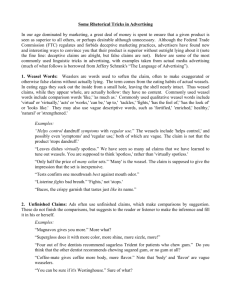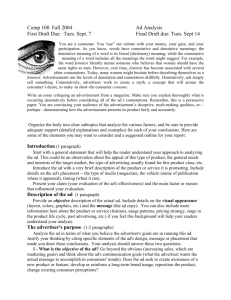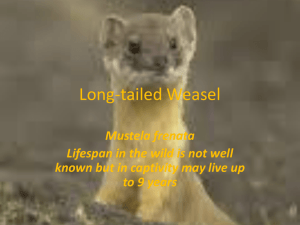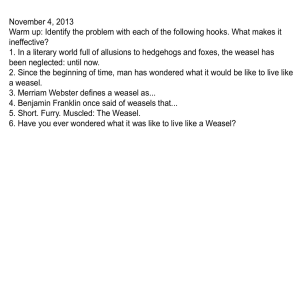Mustela frenata Description males: total length 330-420mm (13-16.5in), weight 160-450g (5.6-16oz)
advertisement
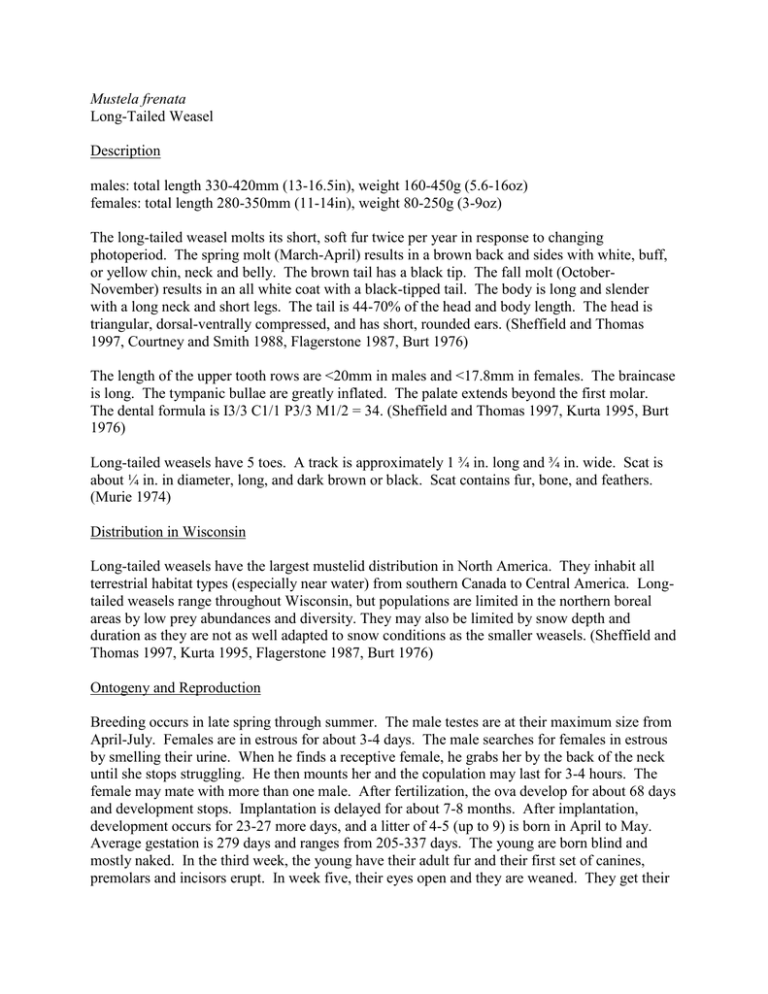
Mustela frenata Long-Tailed Weasel Description males: total length 330-420mm (13-16.5in), weight 160-450g (5.6-16oz) females: total length 280-350mm (11-14in), weight 80-250g (3-9oz) The long-tailed weasel molts its short, soft fur twice per year in response to changing photoperiod. The spring molt (March-April) results in a brown back and sides with white, buff, or yellow chin, neck and belly. The brown tail has a black tip. The fall molt (OctoberNovember) results in an all white coat with a black-tipped tail. The body is long and slender with a long neck and short legs. The tail is 44-70% of the head and body length. The head is triangular, dorsal-ventrally compressed, and has short, rounded ears. (Sheffield and Thomas 1997, Courtney and Smith 1988, Flagerstone 1987, Burt 1976) The length of the upper tooth rows are <20mm in males and <17.8mm in females. The braincase is long. The tympanic bullae are greatly inflated. The palate extends beyond the first molar. The dental formula is I3/3 C1/1 P3/3 M1/2 = 34. (Sheffield and Thomas 1997, Kurta 1995, Burt 1976) Long-tailed weasels have 5 toes. A track is approximately 1 ¾ in. long and ¾ in. wide. Scat is about ¼ in. in diameter, long, and dark brown or black. Scat contains fur, bone, and feathers. (Murie 1974) Distribution in Wisconsin Long-tailed weasels have the largest mustelid distribution in North America. They inhabit all terrestrial habitat types (especially near water) from southern Canada to Central America. Longtailed weasels range throughout Wisconsin, but populations are limited in the northern boreal areas by low prey abundances and diversity. They may also be limited by snow depth and duration as they are not as well adapted to snow conditions as the smaller weasels. (Sheffield and Thomas 1997, Kurta 1995, Flagerstone 1987, Burt 1976) Ontogeny and Reproduction Breeding occurs in late spring through summer. The male testes are at their maximum size from April-July. Females are in estrous for about 3-4 days. The male searches for females in estrous by smelling their urine. When he finds a receptive female, he grabs her by the back of the neck until she stops struggling. He then mounts her and the copulation may last for 3-4 hours. The female may mate with more than one male. After fertilization, the ova develop for about 68 days and development stops. Implantation is delayed for about 7-8 months. After implantation, development occurs for 23-27 more days, and a litter of 4-5 (up to 9) is born in April to May. Average gestation is 279 days and ranges from 205-337 days. The young are born blind and mostly naked. In the third week, the young have their adult fur and their first set of canines, premolars and incisors erupt. In week five, their eyes open and they are weaned. They get their adult teeth and have adult weight in week 11-12 and disperse soon after. Females mate their first summer in July-August at 3-4 months old. Adult females that gave birth come back into estrous 65-104 days after parturition. Males begin mating when they are 15 months old. (Sheffield and Thomas 1997, Kurta 1995, Flagerstone 1987, Burt 1976) Ecology and Behavior General Habits Weasels are mostly nocturnal but are often active during the day. They are solitary for most of the year. They can swim, climb trees, and burrow through snow. Latrines are located at den entrances and often contain bones and skin of prey. They are more active in the cool and cold weather and seem to get lethargic in hot weather. They produce three major vocalizations. A trill is emitted when the weasel is calm. A screech is used if disturbed. A squeal is used as a distress call. When disturbed or distressed, a weasel may release a strong scent from glands on either side of the anus. This is typical of most mustelids. (Kristensen 1997, Sheffield and Thomas 1997, Kurta 1995, Flagerstone 1987, Burt 1976) Food Habits Long-tailed weasels have a high metabolic rate and need to eat 20-70% of their body weight per day depending on season and activity level. They are generalists, taking a wide variety of prey. The main food source is small mammals, especially voles, mice, and rabbits, but also rats, lemmings, muskrats, pocket gophers, shrews, moles, ground squirrels, tree squirrels, flying squirrels, chipmunks, bats, and snowshoe hare. In some ecosystems, long-tailed weasels are the primary predator of flying squirrels. They do prey on least weasels and ermine on occasion. They also prey on birds, eggs, snakes, frogs, and insects. They also eat carrion such as deer, beaver, and woodchuck. Berries are sometimes consumed. Prey is often killed in excess and sometimes cached for later use. (Sheffield and Thomas 1997, Kurta 1995, Wilson and Carey 1994, Flagerstone 1987) Weasels burrow under the snow, climb trees, and enter burrows in search of prey. On the ground, they tend to search in a zig-zag pattern to cover the most area. Weasels have keen smell and hearing but their eyes aren’t very good. When a weasel smells or hears prey, it will try to get close enough to see it and then give chase. When the animal is caught, the weasel will wrap its body around the prey and bite it repeatedly at the base of the skull severing and crushing the spinal cord and vertebrae. Underground, the weasel will just bite down on the throat of the prey to suffocate it. This conserves energy and is feasible because the prey can’t struggle as much in the tight burrows. Capture success is correlated with prey size and the prey’s ability to perceive danger and escape from the weasel. (Doyle 1998, Sheffield and Thomas 1997, Kurta 1995, Flagerstone 1987) Habitat The long-tailed weasel is found in almost any habitat where their prey is found, especially edges and near water. They prefer areas with dense understories, slash with dense regrowth, pastures, fields, prairies, and marshes. In general, they prefer any area with abundant prey and high prey diversity. They seem to have a particular affinity to areas near water and may have to drink water everyday. Waterways seem to be important for dispersal of young. (Sheffield and Thomas 1997, Kurta 1995, Flagerstone 1987, Burt 1976) They use dens of burrowing animals for cover and rest. Females nest in burrows and under brush and rock piles. The nest is 3.5-5 cm across and is lined with grass and the fur of prey. (Sheffield and Thomas 1997, Kurta 1995, Flagerstone 1987, Burt 1976) Mortality The main source of mortality for long-tailed weasels is predators. Red fox, gray fox, coyotes, owls, and hawks account for most of the predation. The black-tipped tail is thought to confuse predators (especially raptors) and causes them to attack the tail, allowing the weasel to get away. The ability to climb trees is often used as a defense against ground predators. Dogs, cats, and large snakes will also take weasels. Weasels are susceptible to canine distemper and ectoparasites. Human induced mortality includes hunting, trapping, and automobile collisions. (Kristensen 1997, Sheffield and Thomas 1997, Kurta 1995, Dekker 1994, Flagerstone 1987, Powell 1982) Density and HomeRanges Density and home range depends on prey abundance and prey diversity. Long-tailed weasels are solitary animals except during rearing young and breeding. In general, home ranges of weasels of the same sex do not overlap, but they are not strongly territorial. Males’ home ranges are much bigger than females’ and will overlap several of the females’ home ranges. Home ranges are normally 12-16 ha (30-40 acres) but range from 10-160 ha (25-395 acres). Densities range from 0.4-38/km2 (1-98/mi2). Males travel up to 5.6 km (3.5 mi) per night. Females travel up to 0.8 km (.5 mi) per night. (Sheffield and Thomas 1997, Flagerstone 1987, Burt 1976) Remarks The long-tailed weasel can be a nuisance on poultry farms where it will kill more chickens than it can eat; however, weasels benefit humans by reducing pest species (mice and rats). Weasels are also important economically as a furbearer. They are trapped for their winter coats and the soft, white fur (along with that of the short-tailed weasel) is marketed as “ermine.” (Sheffield and Thomas 1997, Flagerstone 1987, Burt 1976) Fox and coyotes have been shown to limit long-tailed weasel populations. The increasing populations of wild canids (fox and coyotes) as well as domestic and feral cats and dogs could have a negative effect on these weasels. (Dekker 1994, Flagerstone 1987) Weasels currently have no special status in Wisconsin and are unprotected. They are fairly common but little research has been done on the population dynamics of weasels in Wisconsin. Literature Cited Burt, W. H. 1976. Mammals. Third Edition. Houghton Mifflin Company, New York, New York, USA. Courtney, R. F. and N. J. Smith. 1988. Identifying long-tailed weasels on the prairies. Blue Jay 46(2):93-96. Dekker, D. 1994. Why do long-tailed weasels climb trees? And why have they become so rare?. Alberta Naturalist 24(2):35. Doyle, D. 1998. Observations on the foraging behavior of the long-tailed weasel (Mustela frenata) and the ermine (M. erminea). Alberta Naturalist 28(2):31-32. Flagerstone, K. A. 1987. Black-footed ferret, long-tailed weasel, short-tailed weasel, and least weasel. p. 548-473, in Wild furbearer management and conservation in North America. (ed. M. Novac, J. A. Baker, M. E. Obbard, and B. Malloch). Ontario Ministry of Resources, Toronto. 1150 pp. Kristensen, J. 1997. Observations of long-tailed weasels. Alberta Naturalist 27(3):61-62. Kurta, A. 1995. Mammals of the Great Lakes Region. Revised Edition. University of Michigan Press, Ann Arbor, Michigan, USA. Murie, O. J. 1974. Animal Tracks. Second Edition. Houghton Mifflin Company, New York, New York, USA. Powell, R. A. 1982. Evolution of black-tipped tails in weasels: predator confusion. American Naturalist 119(1):126-131. Sheffield, S. R. and H. H. Thomas. 1997. Mustela frenata. Mammalian Species 570:1-9. Wilson, T. M. and A. B. Carey. 1994. Weasels: underrated predators of northwest forests. Northwest Science 68(2):157. Reference written by John Severson, Biol 378: Edited by Chris Yahnke. Page last updated

